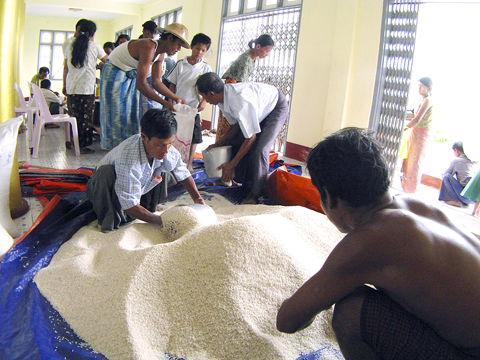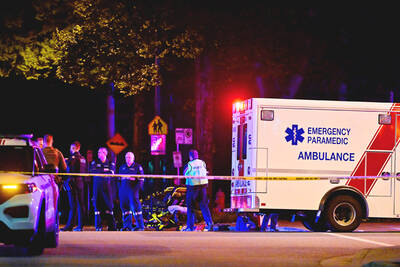In helping others, Myanmar’s saffron-robed Buddhist monks have helped themselves.
The monks’ critical role in providing relief after Cyclone Nargis has galvanized their ranks and strengthened their political voice — just months after the junta quashed the democracy uprising spearheaded by the monks last fall.
The monks have channeled aid materials into stricken regions and turned monasteries into soup kitchens and refugee camps since the May 2-3 storm.

PHOTO: AP
Their outreach to survivors — many of whom received little or no government help — highlighted the monks’ power and the possibility they could clash again with Myanmar’s ruling forces. Some monks are even building secret stashes of makeshift weapons, clerics say.
While Buddhism orders its clergy to shun violence and politics, monks in Myanmar and elsewhere in Asia have a history of militancy.
The monk Saya San became a national hero in the 1930s by leading a revolt against the British colonialists who hanged him after fielding 12,000 troops to suppress his peasant army.
In more recent times, monks were at the forefront of a 1988 uprising against the junta and led mass street demonstrations which the military crushed last fall.
An expert on Myanmar affairs, retired Rutgers University professor Josef Silverstein, said the monks’ post-storm mobilization is consistent with beliefs of Buddhist in the country.
“These beliefs didn’t disappear because the military hit them over the head last year,” he said by telephone. “The monks are angry and they’re seeing that no one else is stepping forward” to lead relief efforts — or political opposition.
A Yangon monk — one of a dozen interviewed — said it was impossible to “close our eyes to a government that cares so little for the people that it allows them to suffer and die.” He spoke on condition of anonymity because of the intense government scrutiny of monks and the sensitivity of discussing anti-government action in this tightly controlled nation.
His monastery has collected and distributed truckloads of blankets, tarpaulins and food to storm survivors. And, like hundreds of other monasteries throughout Myanmar’s storm-struck southwest, it also became a temporary shelter for those who lost their homes.
Short and wiry with fiery eyes, the monk spoke in hushed but urgent tones as he blamed the ruling generals for failing to adequately warn people of the cyclone, which killed at least 78,000 and left an additional 56,000 missing.
He also blamed government restrictions on foreign aid for putting millions of survivors at risk of starvation and disease.
“As monks, it’s our responsibility to fight for a change,” said the monk, as he fingered a scar that he said came from a melee with authorities during last September’s crackdown.
He displayed part of a secret cache, consisting of a half-dozen slingshots, and said he was working with monks in several cities to collect more weapons for storage at other secret locations. Most of them were rudimentary devices patched together from everyday objects such as bamboo rods and bicycle spokes and chains, he said, declining to give numbers and other details for security reasons.
The extent of the weapons gathering could not be independently confirmed.
But other monks interviewed in Yangon and Mandalay said they had heard of colleagues building weapons stashes, though they stressed they were not hoarding weapons themselves.
Monks are also trying to obtain guns to make any clashes “less one-sided,” said the Yangon monk.
Though Myanmar’s monks often explain their relief work in religious terms, some acknowledge its political undertones.
“Whenever you do things for the people, you are engaging in politics,” said U Zaw Ti Ka, an elderly abbot at another monastery in Mandalay. “Here the government is against the people, so if you do something for the people, you are also doing it against the government.”
He said he abhors the violence that marred September’s protests — but understands those who want to use force against the government.
“To make a Christian comparison, this is a real David and Goliath situation,” the monk said. “What we need now are not slingshots. What we need are real guns.”

Archeologists in Peru on Thursday said they found the 5,000-year-old remains of a noblewoman at the sacred city of Caral, revealing the important role played by women in the oldest center of civilization in the Americas. “What has been discovered corresponds to a woman who apparently had elevated status, an elite woman,” archeologist David Palomino said. The mummy was found in Aspero, a sacred site within the city of Caral that was a garbage dump for more than 30 years until becoming an archeological site in the 1990s. Palomino said the carefully preserved remains, dating to 3,000BC, contained skin, part of the

TRUMP EFFECT: The win capped one of the most dramatic turnarounds in Canadian political history after the Conservatives had led the Liberals by more than 20 points Canadian Prime Minister Mark Carney yesterday pledged to win US President Donald Trump’s trade war after winning Canada’s election and leading his Liberal Party to another term in power. Following a campaign dominated by Trump’s tariffs and annexation threats, Carney promised to chart “a new path forward” in a world “fundamentally changed” by a US that is newly hostile to free trade. “We are over the shock of the American betrayal, but we should never forget the lessons,” said Carney, who led the central banks of Canada and the UK before entering politics earlier this year. “We will win this trade war and

‘BODIES EVERYWHERE’: The incident occurred at a Filipino festival celebrating an anti-colonial leader, with the driver described as a ‘lone suspect’ known to police Canadian police arrested a man on Saturday after a car plowed into a street party in the western Canadian city of Vancouver, killing a number of people. Authorities said the incident happened shortly after 8pm in Vancouver’s Sunset on Fraser neighborhood as members of the Filipino community gathered to celebrate Lapu Lapu Day. The festival, which commemorates a Filipino anti-colonial leader from the 16th century, falls this year on the weekend before Canada’s election. A 30-year-old local man was arrested at the scene, Vancouver police wrote on X. The driver was a “lone suspect” known to police, a police spokesperson told journalists at the

North Korean leader Kim Jong-un has unveiled a new naval destroyer, claiming it as a significant advancement toward his goal of expanding the operational range and preemptive strike capabilities of his nuclear-armed military, state media said yesterday. North Korea’s state-run Korean Central News Agency (KCNA) said Kim attended the launching ceremony for the 5,000-tonne warship on Friday at the western port of Nampo. Kim framed the arms buildup as a response to perceived threats from the US and its allies in Asia, who have been expanding joint military exercises amid rising tensions over the North’s nuclear program. He added that the acquisition